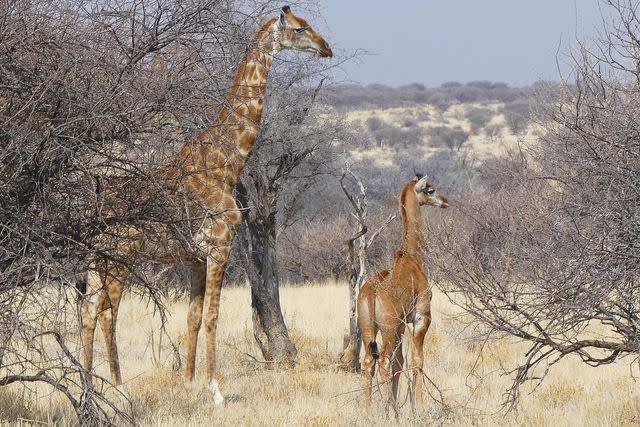Rare Spotless Giraffe Photographed in the Wild Weeks After Birth of Similar Calf at U.S. Zoo
The sighting follows the July 31 birth of a spotless giraffe calf named Kipekee at a Tennessee zoo

Eckart Demasius & Giraffe Conservation Foundation
Spotless Angolan giraffe calf photographed in Namibia with motherAnd then there were two!
Following the July 31 birth of a spotless giraffe at the Brights Zoo in Limestone, Tennessee — then considered the only living patternless giraffe in the world — another of the rare creatures was photographed in the wild in Namibia, according to the Giraffe Conservation Foundation (GCF).
Per a release from the nonprofit, a young Angolan giraffe without the animal's distinctive pattern was recently photographed on a private game reserve, making it the first spotless giraffe recorded in Africa.
The arrival of a solid brown baby giraffe at the Brights Zoo earlier in the summer marked the second record of a spotless giraffe in the world. Another was born at Ueno Zoo in Japan in 1972.
The Brights Zoo's female reticulated giraffe, named Kipekee — Swahili for "unique" — has drawn worldwide attention and curiosity.
"Giraffe experts believe [Kipekee] is the only solid-colored reticulated giraffe living anywhere on the planet," Bright told PEOPLE last month, adding that a giraffe's lifespan is about 25 to 30 years.

Eckart Demasius & Giraffe Conservation Foundation
Spotless Angolan giraffe calf photographed in Namibia with motherWhile color variations or changes in spot or stripe patterns in various species are not uncommon, the exact cause of the spotless coat variation in these two giraffes is unclear.
"The lack of spots could be caused by genetic mutations or recessive genotype in one or more genes related to the pattern, but without detailed genetic analysis, these are mere speculations," Dr. Julian Fennessy, GCF's co-founder and director of conservation, said in a release.
"GCF, together with our partner, the Senckenberg Biodiversity and Climate Research Centre, has done the most detailed research on giraffe genetics in the wild, but it would be difficult to comment on the specifics of these two giraffes."
Related: Meet the Dwarf Giraffes Who Have Baffled Scientists — and Stolen Hearts
GCF hopes that interest in the two rare giraffes will inspire people to support giraffe conservation efforts at a critical time. "Giraffe are in trouble, and if we don't act now, our grandchildren might not be able to see any giraffe in the wild when they grow up," Stephanie Fennessy, GCF's executive director and co-founder, said.
Bright shared a similar urgency. "The international coverage of our patternless baby giraffe has created a much-needed spotlight on giraffe conservation," he told PEOPLE in early September. "Wild populations are slightly slipping into extinction, with 40% of the wild giraffe population lost in just the last three decades."
Bright said he believes Kipekee could help reverse the dismaying trend.
"Keep an eye on her," he said. "This is the best way for a zoo to get out the word for conservation. We need everybody to get involved to help protect wild giraffes. She has the ability to be the spokesperson for that."

Eckart Demasius & Giraffe Conservation Foundation
Spotless Angolan giraffe calf photographed in Namibia with motherNever miss a story — sign up for PEOPLE's free daily newsletter to stay up-to-date on the best of what PEOPLE has to offer, from juicy celebrity news to compelling human interest stories.
Indeed, since her arrival, Kipekee has been drawing large crowds of animal lovers to the Tennessee zoo. A record-breaking number of people — more than 10,000 — visited the. private zoo over Labor Day weekend alone, according to Bright.
"Everybody wants to see this," the zoo director told PEOPLE. "People from all over the world."
Related: Indianapolis Zoo Announces Historic Elephant Birth
Bright recalled Kipekee's birth and the surprising discovery that she didn't look like the other giraffes at his zoo. "We immediately noticed that this baby is totally different than anything we've ever seen," he shared. "It was definitely a shock."
The zoo's staff called other zoos and veterinarians at the University of Tennessee to ask if they had ever seen or heard of a spotless giraffe like Kipekee after the calf's birth.
"Even the old-old timers who are in their 80s have never heard of this. So we knew it was pretty unique," Bright said, adding that scientists plan to visit the zoo and take thermal images of the giraffe to learn more about her unique brown coat.
For more People news, make sure to sign up for our newsletter!
Read the original article on People.

 Yahoo News
Yahoo News 
